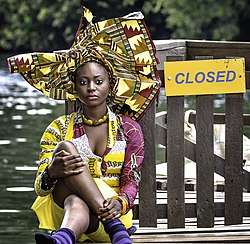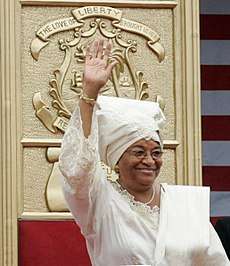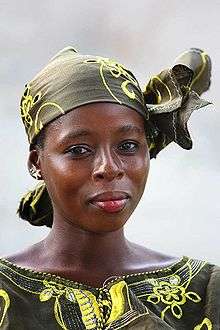Head tie
A head tie is a women's cloth head scarf that is commonly worn in many parts of West Africa and Southern Africa. The head tie is used as an ornamental head covering or fashion accessory, or for functionality in different settings. Its use or meaning can vary depending on the country and/or religion of those who wear it. There are varying traditional names for headties in different countries, which include: gele (Nigeria), duku (Malawi, Ghana), dhuku (Zimbabwe), tukwi (Botswana), and doek (South Africa, Namibia).[1]



West Africa
In Nigeria, the head-ties are known as gele (a Yoruba-language word), and can be rather large and elaborate. Although the gele can be worn for day-to-day activities, the elaborate ceremonial ones are worn to weddings, special events, and church activities.[2] It is usually made of a material that is firmer than regular cloth. When worn, especially for more elaborate events, the gele typically covers a woman's entire hair as well as her ears. The only part exposed is her face and earrings on the lower part of her earlobes. The gele is accompanied by traditional local attire that may or may not have the same pattern as the headtie itself.[3]
In Ghana, opportunity to wear a duku usually falls on a religious day of Friday, Saturday or Sunday. This depends on whether the wearers are Muslim, Seventh-Day Adventists or Sunday church-going Christians.
Southern Africa
In South Africa and Namibia, the Afrikaans word doek (meaning "cloth") is used for the traditional head covering used among most elderly local women in rural areas. Malawian head-ties are usually small and conservative compared to the Nigerian style. Women wear duku at special events like funerals. Urban women with plaited hair also wear a duku when visiting rural areas out of cultural respect. In addition, women may wear duku during sleep to protect the hair.[4]
In South African church services women may wear white "dukus" to cover their heads. At the International Pentecostal churches in South Africa, married women wear white 'dukus'.
The Shangaan women in Zimbabwe and South Africa wear 'dukus' as fashion accessories.[5][6] At other social gatherings in Zimbabwe women may wear a dhuku.[6]
According to Professor Hlonipha Mokoena of the Witwatersrand Institute for Social and Economic Research,[7] historically the doek or headscarf was imposed on black women in many colonies by convention or by law as a way to control the sensuality and exoticism that “confused” white men.[8] However, 2016 saw a resurgence of wearing doeks through the #FeesMustFall movement among students around South Africa.[9][10]
References
- "Lupita Nyong'o, Who Designed Your Nigerian-Style Head Tie?". NPR.org. Retrieved 2020-05-24.
- "Make Up by Marah". www.marahglitz.co.za. Retrieved 2020-05-28.
- "Make Up by Marah". www.marahglitz.co.za. Retrieved 2020-05-28.
- "African Head Gear and African Identity". Global Black History. 2016-06-13. Retrieved 2020-05-24.
- ""Shangaan Woman"". Evan Church. Archived from the original on 10 July 2011. Retrieved 2013-10-08.
- D., Cannon (19 April 2000). "Culture of Zimbabwe". Winthrop, Iowa: East Buchanan Community School District. Archived from the original on 16 July 2004. Retrieved 8 October 2013.
- "Hlonipha Mokoena". WiSER. Wits Institute for Social & Economic Research, University of Witwatersrand. Retrieved 11 October 2017.
- Khoabane, Rea (31 January 2016). "Doeks: mark of a good woman – or a bad hair day?". Sunday Times. TimesLIVE. Archived from the original (PDF) on 14 February 2017.
- Khoabane, Rea (2 June 2016). "The doek - more than just a fashion statement". Sowetan LIVE. Tiso Blackstar Group.
- Pumza Fihlani (11 June 2016). "How South African women are reclaiming the headscarf". BBC News. Johannesburg.
External links
- "How to tie or wear your African head-gear (gele)". Africastyles. 2014.
- Thony Anyiam (2013). "How to tie headwrap and wrapper". Anyiams Creations International.
- "Career Wear: Abada ca-1016". Africastyles. Retrieved 11 October 2017.
- "Elegant Evening Wear: Mali High Klass ee-1370". Africastyles. Retrieved 11 October 2017.
- Dozie Okpalaobieri (6 March 2006). "In pictures: Nigerian Igbo wedding". BBC News.
- "Why I love Africa: BBC listeners and readers share their personal experiences of the African continent". BBC News. 1 December 2005.